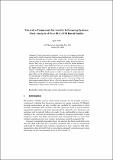| dc.contributor.author | Stibe, Agnis | |
| dc.date.accessioned | 2017-04-21T13:27:04Z | |
| dc.date.available | 2017-04-21T13:27:04Z | |
| dc.date.issued | 2015-06 | |
| dc.identifier.issn | 0302-9743 | |
| dc.identifier.issn | 1611-3349 | |
| dc.identifier.uri | http://hdl.handle.net/1721.1/108333 | |
| dc.description.abstract | People continuously experience various types of engagement through social media, mobile interaction, location-based applications, and other technologically advanced environments. Often, integral parts of such socio-technical contexts often are information systems designed to change behaviors and attitudes of their users by leveraging powers of social influence, further defined as socially influencing systems (SIS). Drawing upon socio-psychological theories, this paper initially reviews and presents a typology of relevant social influence aspects. Following that, it analyzes four partial least squares structural equation modeling (PLS-SEM) based empirical studies to examine the interconnectedness of their social influence aspects. As a result, the analysis provides grounds for seminal steps towards the development and advancement of a framework for designing and evaluating socially influencing systems. The main findings can also deepen understanding of how to effectively harness social influence for enhanced user engagement in socio-technical environments and guide persuasive engineering of future socially influencing systems. | en_US |
| dc.language.iso | en_US | |
| dc.publisher | Springer, Cham | en_US |
| dc.relation.isversionof | http://dx.doi.org/10.1007/978-3-319-20306-5_16 | en_US |
| dc.rights | Article is made available in accordance with the publisher's policy and may be subject to US copyright law. Please refer to the publisher's site for terms of use. | en_US |
| dc.source | Stibe | en_US |
| dc.title | Towards a Framework for Socially Influencing Systems: Meta-analysis of Four PLS-SEM Based Studies | en_US |
| dc.type | Article | en_US |
| dc.identifier.citation | Stibe, Agnis. “Towards a Framework for Socially Influencing Systems: Meta-Analysis of Four PLS-SEM Based Studies.” Lecture Notes in Computer Science (2015): 172–183. © 2015 Springer International Publishing Switzerland | en_US |
| dc.contributor.department | Massachusetts Institute of Technology. Media Laboratory | en_US |
| dc.contributor.approver | Stibe, Agnis | en_US |
| dc.contributor.mitauthor | Stibe, Agnis | |
| dc.relation.journal | Persuasive Technology | en_US |
| dc.eprint.version | Author's final manuscript | en_US |
| dc.type.uri | http://purl.org/eprint/type/ConferencePaper | en_US |
| eprint.status | http://purl.org/eprint/status/NonPeerReviewed | en_US |
| dspace.orderedauthors | Stibe, Agnis | en_US |
| dspace.embargo.terms | N | en_US |
| dc.identifier.orcid | https://orcid.org/0000-0003-2523-4535 | |
| mit.license | PUBLISHER_POLICY | en_US |
| mit.metadata.status | Complete | |
